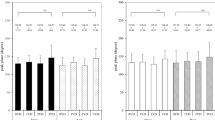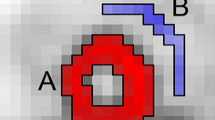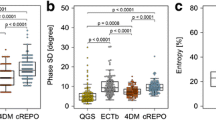Abstract
Objective
The association between left ventricular (LV) dyssynchrony parameters, given by phase analysis of gated single photon emission computed tomography (SPECT) myocardial perfusion imaging (MPI), and acquisition orbits is unclear. The aim of this study was to assess the dependence of LV dyssynchrony parameters on acquisition orbits.
Methods
Ninety-nine patients who underwent 201Tl-gated SPECT MPI were categorized into minor hypoperfusion or major hypoperfusion groups. Forty-four patients who underwent 99mTc-tetrofosmin-gated SPECT MPI were categorized into minor hypoperfusion or major hypoperfusion groups. The major hypoperfusion group with 201Tl was divided into inferior or non-inferior wall hypoperfusion subgroups, and anteroseptal or non-anteroseptal wall hypoperfusion subgroups. Gated SPECT MPI data over a 360° acquisition orbit (360° images) and a 180° acquisition orbit (180° images) were reconstructed, and histogram bandwidth (HBW) and phase standard deviation (PSD) were compared.
Results
Between 360° and 180° images with 201Tl, there were significant differences in HBW and PSD both globally (HBW 34.8 ± 16.6 vs. 29.1 ± 10.2; PSD 8.8 ± 4.9 vs. 7.0 ± 2.3, p < 0.05 for both) and in the inferior wall (HBW 29.5 ± 15.5 vs. 23.3 ± 9.0; PSD 7.6 ± 4.6 vs. 5.6 ± 2.4, p < 0.001 for both) in the major hypoperfusion group, and also in the inferior wall in all subgroups of the major hypoperfusion group. In contrast, no segment had any significant differences in HBW or PSD between 360° and 180° images with 99mTc.
Conclusion
Differences in acquisition orbit had a significant influence on HBW and PSD with 201Tl-gated SPECT MPI in the inferior wall in patients with major hypoperfusion myocardium.




Similar content being viewed by others
References
Westenberg JJM, Lamb HJ, van der Geest RJ, Bleeker GB, Holman ER, Schalij MJ, et al. Assessment of left ventricular dyssynchrony in patients with conduction delay and idiopathic dilated cardiomyopathy: head-to-head comparison between tissue doppler imaging and velocity-encoded magnetic resonance imaging. J Am Coll Cardiol. 2006;47:2042–8.
Vilain D, Daou D, Casset-Senon D, Faraggi M, Le Guludec D. Optimal 3-dimensional method for right and left ventricular fourier phase analysis in electrocardiography-gated blood-pool SPECT. J Nucl Cardiol. 2001;8:371–8.
Germano G, Erel J, Lewin H, Kavanagh PB, Berman DS. Automatic quantitation of regional myocardial wall motion and thickening from gated technetium-99m sestamibi myocardial perfusion single-photon emission computed tomography. J Am Coll Cardiol. 1997;30:1360–7.
Chen J, Garcia EV, Folks RD, Cooke CD, Faber TL, Tauxe EL, et al. Onset of left ventricular mechanical contraction as determined by phase analysis of ECG-gated myocardial perfusion SPECT imaging: development of a diagnostic tool for assessment of cardiac mechanical dyssynchrony. J Nucl Cardiol. 2005;12:687–95.
Garcia EV, Faber TL, Cooke CD, Folks RD, Chen J, Santana C. The increasing role of quantification in clinical nuclear cardiology: the Emory approach. J Nucl Cardiol. 2007;14:420–32.
Germano G, Kavanagh PB, Slomka PJ, Van Kriekinge SD, Pollard G, Berman DS. Quantitation in gated perfusion SPECT imaging: the Cedars-Sinai approach. J Nucl Cardiol. 2007;14:433–54.
Van Kriekinge SD, Nishina H, Ohba M, Berman DS, Germano G. Automatic global and regional phase analysis from gated myocardial perfusion SPECT imaging: application to the characterization of ventricular contraction in patients with left bundle branch block. J Nucl Med. 2008;49:1790–7.
Ypenburg C, Schalij MJ, Bleeker GB, Steendijk P, Boersma E, Dibbets-Schneider P, et al. Impact of viability and scar tissue on response to cardiac resynchronization therapy in ischaemic heart failure patients. Eur Heart J. 2007;28:33–41.
Abraham WT, Fisher WG, Smith AL, Delurgio DB, Leon AR, Loh E, et al. Cardiac resynchronization in chronic heart failure. N Engl J Med. 2002;346:1845–53.
Leclercq C, Kass DA. Retiming the failing heart: principles and current clinical status of cardiac resynchronization. J Am Coll Cardiol. 2002;39:194–201.
Henneman MM, Chen J, Ypenburg C, Dibbets P, Bleeker GB, Boersma E, et al. Phase analysis of gated myocardial perfusion single-photon emission computed tomography compared with tissue Doppler imaging for the assessment of left ventricular dyssynchrony. J Am Coll Cardiol. 2007;49:1708–14.
Boogers MM, Van Kriekinge SD, Henneman MM, Ypenburg C, Van Bommel RJ, Boersma E, et al. Quantitative gated SPECT-derived phase analysis on gated myocardial perfusion SPECT detects left ventricular dyssynchrony and predicts response to cardiac resynchronization therapy. J Nucl Med. 2009;50:718–25.
Henneman MM, Chen J, Dibbets-Schneider P, Stokkel MP, Bleeker BG, Ypenburg C, et al. Can LV dyssynchrony as assessed with phase analysis on gated myocardial perfusion SPECT predict response to CRT? J Nucl Med. 2007;48:1104–11.
Chen C-C, Shen T-Y, Chang M-C, Hung G-U, Chen W-C, Kao C-H, et al. Stress-induced myocardial ischemia is associated with early post-stress left ventricular mechanical dyssynchrony as assessed by phase analysis of 201Tl gated SPECT myocardial perfusion imaging. Eur J Nucl Med Mol Imaging. 2012;39:1904–9.
Huang W-S, Huang C-H, Lee C-L, Chen C-P, Hung G-U, Chen J. Relation of early post-stress left ventricular dyssynchrony and the extent of angiographic coronary artery disease. J Nucl Cardiol. 2014;21:1048–56.
Liu Y-H, Lam PT, Sinusas AJ, Wackers FJT. Differential effect of 180 degrees and 360 degrees acquisition orbits on the accuracy of SPECT imaging: quantitative evaluation in phantoms. J Nucl Med. 2002;43:1115–24.
Nakajima K, Taki J, Yamamoto W, Michigishi T, Tonami N. Effect of 360 degrees and 180 degrees rotation SPET acquisitions on myocardial polar map: comparison of 201Tl-, 99Tcm- and 123I-labelled radiopharmaceuticals. Nucl Med Commun. 1998;19:315–25.
Nakata T, Hashimoto A, Matsuki T, Yoshinaga K, Tsukamoto K, Tamaki N. Prognostic value of automated SPECT scoring system for coronary artery disease in stress myocardial perfusion and fatty acid metabolism imaging. Int J Cardiovasc Imaging. 2013;29:253–62.
Kusuoka H, Nishimura S, Yamashina A, Nakajima K, Nishimura T. Surveillance study for creating the national clinical database related to ECG-gated myocardial perfusion SPECT of ischemic heart disease: J-ACCESS study design. Ann Nucl Med. 2006;20:195–202.
Nishimura T, Nakajima K, Kusuoka H, Yamashina A, Nishimura S. Prognostic study of risk stratification among Japanese patients with ischemic heart disease using gated myocardial perfusion SPECT: J-ACCESS study. Eur J Nucl Med Mol Imaging. 2008;35:319–28.
Matsuo S, Nakajima K, Horie M, Nakae I, Nishimura T. Prognostic value of normal stress myocardial perfusion imaging in Japanese population. Circ J. 2007;72:611–7.
Matsuo S, Nakajima K, Yamasaki Y, Kashiwagi A, Nishimura T. Prognostic value of normal stress myocardial perfusion imaging and ventricular function in Japanese asymptomatic patients with type 2 diabetes. Circ J. 2010;74:1916–21.
Chen J, Garcia EV, Bax JJ, Iskandrian AE, Borges-Neto S, et al. SPECT myocardial perfusion imaging for the assessment of left ventricular mechanical dyssynchrony. J Nucl Cardiol. 2011;18:685–94.
Galt JR, Garcia EV, Robbins WL. Effects of myocardial wall thickness on SPECT quantification. IEEE Trans Med Imaging. 1990;9:144–50.
He ZX, Cwajg E, Preslar JS, Mahmarian JJ, Verani MS. Accuracy of left ventricular ejection fraction determined by gated myocardial perfusion SPECT with Tl-201 and Tc-99m sestamibi: comparison with first-pass radionuclide angiography. J Nucl Cardiol. 1999;6:412–7.
Germano G, Erel J, Kiat H, Kavanagh PB, Berman DS. Quantitative LVEF and qualitative regional function from gated thallium-201 perfusion SPECT. J Nucl Med. 1997;38:749–54.
Kortelainen MJ, Koivumäki TM, Vauhkonen MJ, Hakulinen MA. Dependence of left ventricular functional parameters on image acquisition time in cardiac-gated myocardial perfusion SPECT. J Nucl Cardiol. 2015;22:643–51.
Beller GA. Diagnostic accuracy of thallium-201 myocardial perfusion imaging. Circulation. 1991;84:I1–I6.
Wang SJ, Chen YT, Hwang CL, Lin MS, Kao CH, Yeh SH. 99mTc-sestamibi can improve the inferior attenuation of TL-201 myocardial spect imaging. Int J Card Imaging. 1993;9:87–92.
Harel F, Génin R, Daou D, Lebtahi R, Delahaye N, Helal BO, et al. Clinical impact of combination of scatter, attenuation correction, and depth-dependent resolution recovery for 201Tl studies. J Nucl Med. 2001;42:1451–6.
Li D, Zhou Y, Feng J, Yuan D, Cao K, Garcia EV, et al. Impact of image reconstruction on phase analysis of ECG-gated myocardial perfusion SPECT studies. Nucl Med Commun. 2009;30:700–5.
Dorbala S, Di Carli MF, Delbeke D, Abbara S, DePuey EG, Dilsizian V, et al. SNMMI/ASNC/SCCT guideline for cardiac SPECT/CT and PET/CT 1.0. J Nucl Med. 2013;54:1485–507.
Nakajima K, Okuda K, Kawano M, Matsuo S, Slomka P, Germano G, et al. The importance of population-specific normal database for quantification of myocardial ischemia: comparison between Japanese 360 and 180-degree databases and a US database. J Nucl Cardiol. 2009;16:422–30.
Author information
Authors and Affiliations
Corresponding author
Ethics declarations
Conflict of interest
The authors declare no conflict of interest associated with this manuscript.
Rights and permissions
About this article
Cite this article
Misaka, T., Hosono, M., Kudo, T. et al. Influence of acquisition orbit on phase analysis of gated single photon emission computed tomography myocardial perfusion imaging for assessment of left ventricular mechanical dyssynchrony. Ann Nucl Med 31, 235–244 (2017). https://doi.org/10.1007/s12149-017-1151-x
Received:
Accepted:
Published:
Issue Date:
DOI: https://doi.org/10.1007/s12149-017-1151-x




